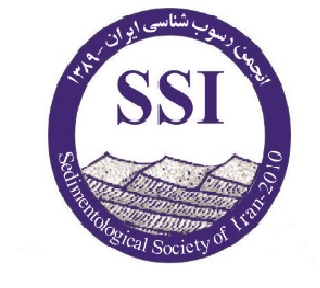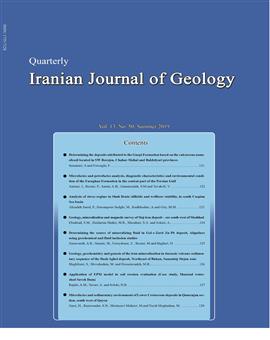Application of EPM model in soil erosion evaluation (Case study, Shazand watershed-Saveh Dam)
Subject Areas :Ali Mohammad Rajabi 1 , Adel Yavari 2 , Hamid Reza Soloki 3
1 - University of Tehran
2 -
3 -
Keywords: Erosion Geographic informationsSystemEPMShazand watershedMaximum annual sediment.,
Abstract :
In this paper, the Shazand catchment area have been simulated using the geographical information system (GIS) with an accuracy of 10 × 10 meters and various parameters required in the form of digital layers in the ArcGIS environment. Then, using the EPM model, the erosion zoning map of this basin located around the Saveh dam was prepared and its annual precipitation rate was estimated. In the following, the output of the model was compared with the hydrometric method. According to the results of EPM model, sediment yield from stations of Poledoab, Bazaneh, Toureh and Shazand using EPM model are 288103.81, 18963.83, 43079.2 and 20583.76 respectively, whereas hydrometric method shows values 335285.42, 23937.42, 36459.09 and 42781.69 ton per year, respectively. Also comparison of EPM model with hydrometric method shows a good correlation. Results show accuracy of 86%, 82%, 48% and 79% for Poledoab, Toureh, Shazand and Bazaneh stations, respectively. Assessments show that EPM model with acceptable accuracy provides good results in order to predict the mximum annual sediment yield.
احمدی، ح.، 1379. ژئومرفولوژی کاربردی (فرسایش آبی). جلد اول. انتشارات دانشگاه تهران، 688.
علیزاده، ا.، 1391. اصول هیدرولوژی کاربردی. انتشارات دانشگاه امام رضا (ع)، 942.
خدابخش، س.، محمدی، ا.، رفیعی، ب. و بزرگزاده، ع.، 1388. مقایسه برآورد میزان فرسایش و رسوب¬زایی در زیرحوضه سزار (حوضه آبریز سد ساوه) با استفاده از مدل¬های تجربی ای¬پی¬ام و ام¬پسیاک با کمک دانش فازی، زمینشناسی (فصل-نامه انجمن زمین¬شناسی ایران)، 12، 51-61.
بهرامی، ع.، مردیان، م. و دلاوری کامیباب، ا.، 1391. تعیین مناسب¬ترین معادلات سنجه رسوب سالانه در ایستگاه هیدرومتری حوضه آبخیز پل دوآب شازند، سومین همایش ملی مقابله با بیابان¬زایی و توسعه پایدار تالاب¬های کویری ایران (اراک).
سازمان جنگلها، مراتع و آبخیزداری کشور، 1383. وزارت جهاد کشاورزی. طرح ملی مطالعات فرسایش استان مرکزی.
راستگو، س.، قهرمان، ب.، ثنایی¬نژاد، ح.، داوری،ک. و خداشناس، س. ر.، 1385. برآورد فرسایش و رسوب حوضه آبخیز تنگ¬کنشت با مدل¬های تجربی MPSIAC و EPM به کمک GIS، مجله علوم و فنون کشاورزی و منابع طبیعی، 104-91.
قضاوی، ر.، ولی، ع.، مقامی، ی.، عبدی، ژ. و شرفی، س.، 1391، مقایسه مدل¬های EPM، MPSIAC و PSIAC در برآورد فرسایش و رسوب با استفاده از GIS، مجله جغرافیا و توسعه ،27،126-117.
محسنی، ب.، قدوسی، ج.، احمدی، ح. و طهماسبی، ر.، 1390. ارزیابی دقت و کارایی مدل¬های EPM، MPSIAC، ژئومورفولوژی و هیدروفیزیکی در برآورد فرسایش و رسوب، مجله جغرافیا و توسعه، 22، 127-107.
Byrne, D., Horsburgh, K., Zachry, B. and Cipollini, P., 2017. Using remotely sensed data to modify wind forcing in operational storm surge forecasting. Nat Hazards. https://doi.org/10.1007/s11069-017-2964-6
Elirehema, Y., 2001. Soil water erosion modeling in selected watersheds in Southern Spain. IFA, ITC, Enschede
Hui, L., Xiaoling, C., Jae Lim, K., Xiaobin, C. and Sagon, M., 2010. Assessment of soil erosion and sediment yield in Liao watershed, Jiangxi Province, China, using USLE, GIS, and RS. Earth Science, 21, 941–953
Manoj Kumar, J. and Debjyoti, D., 2010. Estimation of sediment yield and areas of soil erosion and deposition for watershed prioritization using GIS and remote sensing. Water Resour Manag, 24, 2091–2112
Modallaldoust, S., 2007. Estimation of sediment and erosion with use of MPSIAC and EPM models in GIS environment. Degree Ms. University of Mazandaran, 95.
Peijun, D., Pei, L., Junshi, X., Li, F., Sicong, L., Kun, T. and Liang, C., 2014. Remote sensing image interpretation for urban environment analysis. methods, system and examples. Remote Sens, 6, 9458–9474
Prasannakumar, V., Vijith, H., Geetha, N. and Shiny, R., 2011. Regional scale erosion assessment of a sub-tropical highland segment in the Western Ghats of Kerala, South India. Water Resour Manag, 25, 3715
Rastgoo Ghahreman, S., Senayeenejad, H., Daavari, K. and Khodashenas, S., 2006. Estimating soil erosion and sediment yield in Tang Konasht watershed with MPSIAC, EPM and GIS. Agriculture and Natural Resources Journal, 91-104.
Şahin, Ş. and Kurum, E., 2002. Erosion risk analysis by GIS in environmental impact assessments: a case study-Seyhan Köprü Dam construction. Journal of Environmental Management, 66, 3, 239-247.
Tangestani, M. H., 2006. Comparison of EPM and PSIAC models in GIS for erosion and sediment yield assessment in a semi-arid environment: Afzar Catchment, Fars Province, Iran. Asian Earth Science, 27, 585–597
Wang, G., Gertner, G., Fang, S. and Anderson, A.B., 2003. Mapping multiple variables for predicting soil loss by geostatistical methods with TM images and a slope map.
Photogram Engineering Remote Sensing, 69, 889 – 898
Wischmeier, W., H. and Smith, D., D., 1978. Predicting rainfall erosion losses-A guide to conservation planning. Predicting rainfall erosion losses-A guide to conservation planning.
Zhang, W., Zhou, J., Feng, G., Weindorf, D.C., Hu, G. and Shen, J., 2015. Characteristics of water erosion and conservation practice in arid regions of Central Asia: Xinjiang Province, China as an example. International Soil and Water Conservation Research, 97-111

